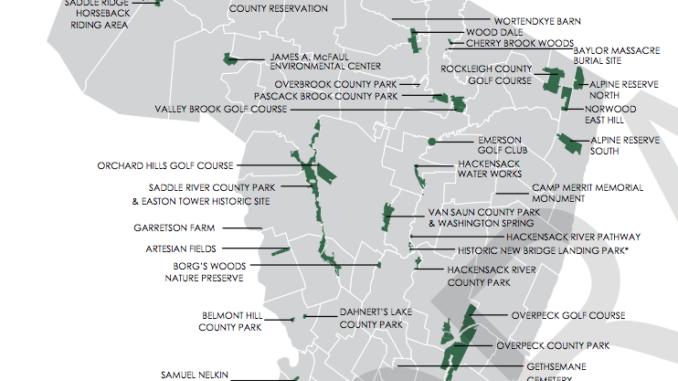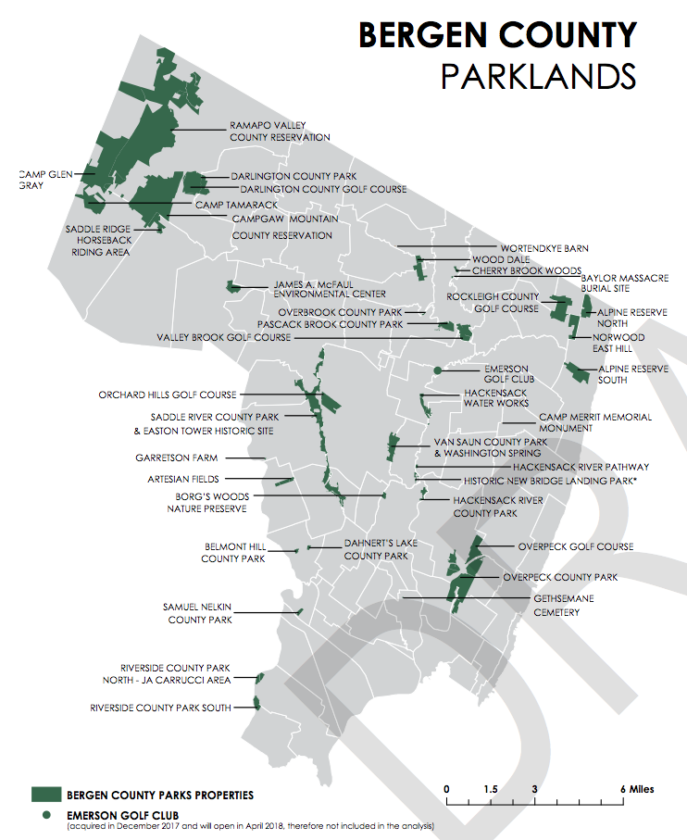
HACKENSACK—While the county park systems’ six golf courses bring in nearly $7 million out of $9 million in annual park revenues, there’s still one amenity in short-supply over the 9,000-plus acres of Bergen County parkland: a lack of well-maintained, accessible and working bathrooms.
That’s according to park users interviewed by a consultant for the new Bergen County Parks system Master Plan—the first in the system’s 70-year history—and final public comments on the future parks plan were due via email by Nov. 21.
Other top-rated park user needs included more walking and hiking trails, bike trails, food and beverage offerings, improved playground maintenance and dog amenities.
The Master Plan report cost $364,800 to produce over three years of research and outreach, said county park officials.
Parks Director James Koth told Northern Valley Press that he hoped to present a final version of the future-focused plan Dec. 4 to the Bergen County Board of Chosen Freeholders.

Interestingly, the report points out that though a majority of $7 million in revenues is raised via the county’s golf courses, the funds are not reinvested in the parks but returned to the county treasury.
Koth, however, told Northern Valley Press Nov. 21 that “the revenues generated by the parks department that are returned to the county’s “general fund” are reallocated within the overall county budget to support the Parks Department’s operating budget.”
County spokesman Michael Pagano provided responses from County Executive James Tedesco III, answering questions on the master plan, including funding for parks improvement projects.
“Whether re-investing in today or planning for tomorrow, funding is always a challenge to overcome, which is why it is more important than ever to continue to explore various means, methods, and opportunities to accomplish some of these objectives for our parks system such as business practices, public-private partnerships, shared services, philanthropic support, etc.,” said Tedesco.
Golf: $7.3 million raised
“The Bergen County parks system currently generates significant revenues from a limited number of sources, including $7,300,000 from golf courses, $985,000 from the Van Saun Park Zoo, $880,000 from permits and rentals, and $200,000 from the Saddle Ridge Riding Center, plus lesser amounts from food and recreation concessions,” states the report.
“However, these proceeds are not dedicated for reinvestment in the parks system. Instead, they are placed into the Bergen County General Fund, which supports a wide variety of programs. The (parks department) operates on an annual budget and capital project appropriations approved by the Bergen County Board of Chosen Freeholders,” notes the draft report.
The report later suggests the funds be reinvested in the county parks system.
“The [parks department] now cares for 9,335 acres of parkland, operating on roughly one-third of the funds the Bergen County Park Commission had 50 years ago when total parkland acreage was approximately 4,000 acres,” the report notes.
“It should be noted that current expenses charged to [county parks department] do not include employee fringe benefits, debt service on bonds that fund park capital projects and land acquisition, or trade services obtained from other county departments.,” it states. “Bergen County is currently investing less in park operations than other northern New Jersey counties with similar populations,” the report notes.
Less spending on parks
The report states Bergen County Parks system spends approximately $13 per resident, whereas a Trust for Public Land survey of cities nationwide showed $19 per resident in Jersey City and up to $478 per resident in St. Louis. Total Morris County spending per resident was $51 in 2017.
As one possible option to provide dedicated funding, the report suggests a sustainable business model for increasing parks revenue, including a newly created business office.
“In order to acquire parklands for the future, to build, repair, and replace park infrastructure, add new programming, and maintain existing parkland, the [parks department] must secure the required funding on a consistent basis. As illustrated in previous goals and objectives, higher revenues could be obtained from events, golf courses, and opportunities for new or enhanced concessions in certain parks,” the report notes.
“However, the maximum benefit from efforts to increase park revenues can only be realized if park-generated income can be used by the [parks department] for reinvestment in county parks,” adds the Master Plan.
In addition to a comprehensive portrait of the parks’ evolution, recreational opportunities and amenities in its 9,335-acre system, the Master Plan offers surveys, graphics and photos depicting a range of active and passive recreational pursuits pursued, from biking, hiking and enjoying time with friends and family to enjoying nature, bird watching, and fitness activities such as jogging, sports, and walking.
Throughout the 117-page parks’ Master Plan, the document lays out the park system’s past, present and future development under different county park system managers.
It details online survey results from from 2,245 participants, plus comments received at 11 stakeholder meetings over three years of outreach.
It provides a list of so-called “anchor parks” such as Overpeck Park, a “linear park” such as Saddle River Park with bicycle/pedestrian pathways, plus a recap of recreational facilities, golf courses, nature preserves and historic sites.
‘Diversify’ golf courses
According to the Master Plan, county golf courses comprise 10 percent of the County’s park acreage, or 933 of 9,335 acres.
With these six courses, the parks system is the “prime provider of public golf in the county… [offering] affordable, challenging, and accessible golf to residents and visitors. We wish to continue to do so and to further diversify and improve the county golf courses,” notes the plan.
The master plan was prepared by the Rutgers Center for Urban Environmental Sustainability under contract to the county parks department.
The report notes the critical role the county’s six golf courses play now and should play in the future.
“In view of contemporary and projected development pressures and the closure of private golf courses in Bergen County, these courses constitute large [tracts] of essential open space with tremendous potential for providing broader service to the community and an opportunity for creative natural resource stewardship,” it adds.
“Many of the environmental conditions in other county parks exist in the golf courses. Water quality issues due to excess nutrient inputs causing eutrophication, eroding stream banks, and invasive species in wetland and riparian corridors are all present.,” adds the report.
To offer more residents varied golf experiences, the report suggests one or more existing courses be renovated to establish everything from a championship-caliber course to a Par-3 or pitch-and-putt course.
“Opportunities to acquire additional golf course properties could be considered if private courses become available. A diversity of golf course types would provide new experiences for area golfers, the possibility of hosting regional or national tournaments, and could provide justification to update the greens fees structure,” the report notes.
Bathrooms: Most requested
The plan noted during public outreach, the amenity most often requested by park visitors was a well-maintained, accessible working bathroom.
“A system-wide evaluation that inventories the type and condition of existing facilities, and explores locations where new restroom facilities are needed could be completed by” the county parks department, said the report.
In addition to improved and functional restrooms, the report noted most survey respondents recommended additional food options in county parks.
“There are opportunities at some county parks to enhance the park experience with expanded food options,” it states.
Historic ‘opportunity’
Further, the report urges consideration of historic properties as potential public event venues, singling out the Hackensack Waterworks facility as one example of “a great untapped opportunity” that could be converted for “modern productive use.”
The report notes competing visions exist for re-use of Hackensack Waterworks but no public entity has committed funds to such an effort. Other possible sites for use as a public outdoor space include Van Buskirk Island.
“It is recommended that Bergen County develop a proposal for long-term lease through a Request For Proposals (RFP) process that would include the incorporation of various elements that stakeholders are looking for in this historic restoration,” says the plan of efforts to preserve and maintain Hackensack Waterworks.
Three-year effort
Surprisingly, the nearly three-year effort to develop a first-ever Master Plan for Bergen County’s parks appears mostly to have gone unreported.
Recently, however, advocates for Northern Valley Greenway—a proposed 7.4-mile linear park on an unused CSX rail line through Northvale, Norwood, Closter, Demarest, Cresskill and Tenafly—expressed concern to Northern Valley Press that their 3-year-old effort to make a rails-to-trail pathway a reality was not included in the county parks’ draft Master Plan (Read the story online at bit.ly/greenwaynotinplan).
Koth said the reason the greenway effort was left out was because the Master Plan does not focus on specific projects, especially projects that are only conceptual and not yet existing. He expressed support for the greenway efforts taking place.
Similarly, Tedesco said he supports the Northern Valley Greenway efforts and a recent NJDOT study found it “could work warranting further study.
“…[T]he purpose of the Master Plan is to set the charge to undertake and pursue these sorts of explorations, not only for [Northern Valley Greenway], but throughout all of Bergen County,” said Tedesco.
Increasing public access
Increasing public access to parks’ information, including an easy to use website, regular emails/texts on park features and programming, improved park signage, a one-stop, up-to-date events calendar, and awareness of park benefits and values via a countywide parks marketing effort are all recommended in the Master Plan.
Underscoring all the proposed efforts, the Master Plan’s “sustainable business model” includes reimagining park offerings and uses, plus exploring opportunities for advertising and sponsorships such as outdoor umbrella and table advertising and food and beverage sponsorships, where appropriate.
It again suggests earmarking current park revenues to boost parks’ upgrades and amenities.
Understaffed parks
Based on historic and other parks’ staffing levels, the current 120 full-time parks employees “are far short of the number of employees needed to maintain the parks system,” notes the plan.
“Implementing this Master Plan requires hiring personnel with expertise in finance and business, marketing, digital technology and environmental stewardship,” it notes.
The Master Plan calls for “dedicated staff” in the county Parks and Recreation Department “to provide some of these key functions. Obtaining these services from other Bergen County departments may not always provide the support desperately needed to preserve, maintain and grow the county park system.”
Following Master Plan adoption by county Freeholders, the report notes a detailed timeline of priorities will be established by the parks department based on the plan’s recommendations.
